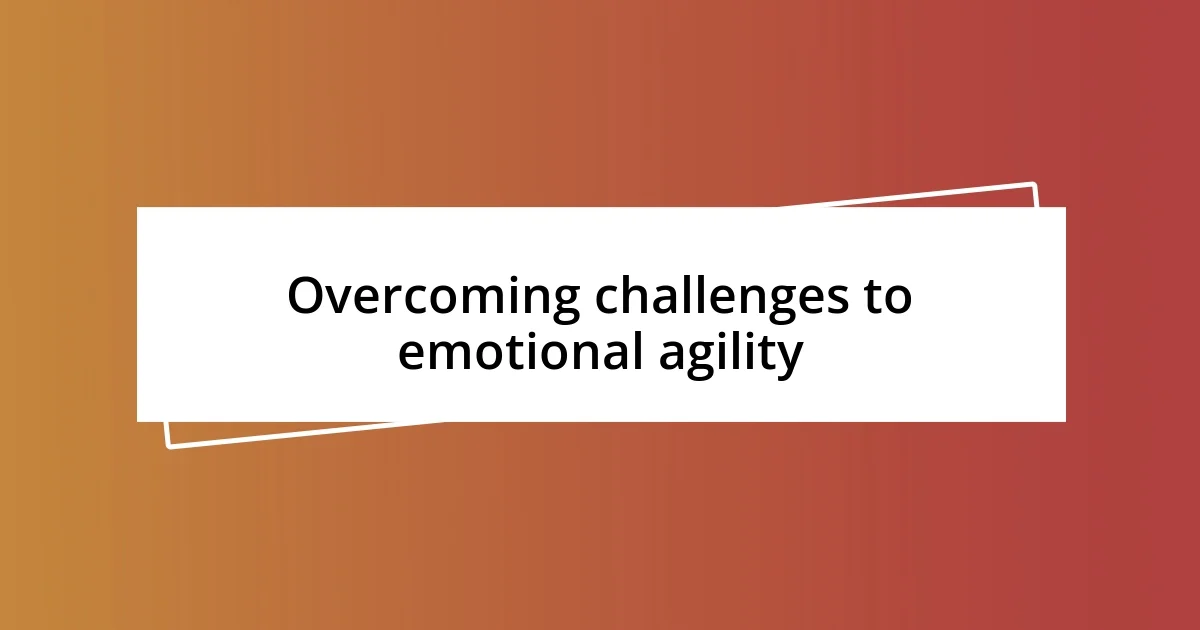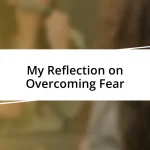Key takeaways:
- Emotional agility involves acknowledging and navigating emotions, allowing for thoughtful responses rather than reactive behaviors.
- Practicing mindfulness, self-reflection, and self-compassion can enhance emotional agility, leading to better decision-making, improved relationships, and increased resilience.
- Overcoming challenges such as fear of vulnerability, rumination, and self-criticism is essential in developing emotional agility, fostering personal growth and deeper connections with others.

Understanding emotional agility
Emotional agility is all about how we navigate our emotions and respond to life’s challenges. I remember a time when I faced a significant setback at work. Instead of dwelling on that frustration, I took a step back, identified the emotions I was feeling, and thought about how I could use them as a learning opportunity. Isn’t it interesting how acknowledging our feelings can sometimes lead to unexpected insights?
This concept encourages us to be flexible and adaptive with our emotional responses. I’ve found that instead of pushing away feelings like anxiety or sadness, accepting them allows me to explore what they teach me. Have you ever noticed that when you name an emotion, it loses some of its power over you? It’s almost liberating to realize that our thoughts and feelings don’t have to dictate our actions.
At its core, emotional agility means not being beholden to our initial reactions. When I’m stuck in a heated moment, I take a breath and ask myself: “What do I truly need here?” This mindset shift not only brings clarity but also reaffirms that our emotions are valid, yet transient. Being able to navigate through them with grace is what ultimately leads us to deeper self-awareness and resilience.

Benefits of emotional agility
Emotional agility can significantly enhance our decision-making abilities. I recall a situation during my university days when I had to choose between two job offers. Instead of letting anxiety cloud my judgment, I took a moment to evaluate what each opportunity meant to me emotionally and professionally. This helped me make a choice that aligned with my values, highlighting how emotional agility can lead to clearer, more confident decisions.
Another benefit is improved relationships. I’ve observed that when I practice emotional agility, I tend to communicate better with friends and family. For instance, when my friend was upset, rather than react defensively, I allowed myself to feel and acknowledge their pain. This practice deepened our connection, showcasing how understanding our own emotions can enhance empathy and communication with others.
Lastly, emotional agility fosters resilience in the face of adversity. I once faced a period of intense stress at work that felt overwhelming. By embracing my emotions rather than avoiding them, I discovered coping strategies that not only helped me manage my workload but also led to innovative solutions. In essence, being emotionally agile equips us with the tools to bounce back and thrive, transforming challenges into opportunities for growth.
| Benefit | Example |
|---|---|
| Better Decision Making | Choosing career options aligned with personal values |
| Improved Relationships | Enhanced empathy and communication with loved ones |
| Increased Resilience | Transforming stress into innovative solutions |

Strategies to develop emotional agility
Developing emotional agility is a journey that can take many forms, but a few strategies have stood out for me as particularly effective. One approach I find valuable is mindfulness. I’ve had moments where I felt overwhelmed with anxiety, so I began practicing meditation daily. It’s fascinating how simply sitting in silence and focusing on my breath can help me ground myself and observe my emotions without judgment. This act of awareness opens up a space where I can respond thoughtfully instead of reacting impulsively.
Here are some strategies that might resonate with you as you seek to cultivate your emotional agility:
- Practice Mindfulness: Take a few moments each day to breathe and notice your thoughts and feelings.
- Reflect on Experiences: After a challenging situation, spend time journaling about what you felt and what you learned from it.
- Reframe Your Thoughts: Challenge negative narratives by finding a more constructive angle; this shift can change how you perceive situations.
- Engage in Self-Compassion: Remind yourself that it’s okay to feel vulnerable; I often tell myself, “It’s human to struggle,” which creates a sense of acceptance.
- Connect with Supportive People: Sharing experiences with trusted friends or family can open up new perspectives and reinforce your emotional resilience.
I remember vividly the first time I tried reframing a thought. During a difficult team project, I felt frustrated with a colleague. Instead of letting that resentment fester, I took a step back and questioned the root of my feelings. What I discovered was enlightening; it wasn’t just about the work, but my own fears of not being heard. By communicating openly with my teammate, not only did we clarify our roles, but we also strengthened our collaboration, turning what could have been a hindrance into an opportunity for growth. This experience deepened my understanding of how flexible I can be in my emotional responses, and it made me appreciate the power of introspection.

Mindfulness practices for emotional agility
When I think about integrating mindfulness into daily life, one practice stands out: mindful walking. I remember walking in the park one afternoon, feeling stressed after a long week. Instead of just moving through the motions, I focused on each step, the sensation of my feet touching the ground, the rhythm of my breath. This simple act shifted my awareness, allowing me to recognize and process my emotions rather than being overwhelmed by them. Have you ever noticed how much your environment can shape your feelings?
Another mindfulness practice I’ve found effective is mindful breathing. There’s something truly grounding about taking a moment to inhale deeply and exhale slowly. I often pause during hectic days for just a minute, focusing solely on my breathing. It creates a small oasis of calm, reminding me that even amidst chaos, I can find a steady anchor. Have you tried something similar? It’s incredible how such a small practice can change your emotional landscape.
Engaging with mindfulness doesn’t always have to be formal or structured. I’ve learned to incorporate it into everyday activities, like sipping my morning coffee. Instead of rushing through that moment, I pause to truly savor the taste and aroma. This practice not only enhances my appreciation of small pleasures but also helps me stay present and aware of my emotions throughout the day. Isn’t it fascinating how mindfulness can transform even the simplest moments into opportunities for emotional growth?

Building resilience through emotional agility
Building resilience is often seen as a reaction to hardship, but I believe emotional agility plays a crucial role in that process. When I faced a significant setback at work, I noticed my first instinct was to shut down emotionally. However, by leaning into my feelings—acknowledging my disappointment and frustration—I found clarity. It was that acceptance, rather than avoidance, that allowed me to bounce back more quickly, transforming a tough situation into a stepping stone for growth. Do you find that facing your emotions head-on helps you build resilience, too?
In my experience, resilience isn’t just about enduring tough times; it’s about adapting and thriving. During a challenging personal period, I practiced emotional agility by recognizing my triggers and how they affected my responses. For instance, when I felt overwhelmed by a family issue, instead of reacting with anger or withdrawal, I took a moment to breathe and explore my feelings. This pause let me respond with empathy rather than frustration. Isn’t it remarkable how a moment of reflection can redefine our reactions and ultimately strengthen our emotional foundations?
Emotional agility empowers us to navigate life’s ups and downs with grace. I vividly recall a time when I was anxious about an upcoming presentation. Instead of letting that anxiety paralyze me, I reframed it as an opportunity to share my ideas. By embracing my nervousness rather than resisting it, I stepped onto the stage feeling more resilient and ready to connect with my audience. Have you found similar ways to reinterpret your emotional responses to cultivate resilience? It’s these small shifts in perspective that can lead to profound personal growth.

Overcoming challenges to emotional agility
Developing emotional agility often feels like navigating a maze filled with obstacles. One challenge I faced was the fear of vulnerability. Sharing my emotions, particularly in a professional setting, always seemed daunting. But I realized that embracing vulnerability was actually a path to connection, not weakness. Have you ever hesitated to share how you truly feel? I found that when I opened up, it not only strengthened my relationships but also eased the burden I carried.
Another hurdle can be the tendency to ruminate over negative experiences. I remember a tough conversation that kept replaying in my mind, making it difficult for me to focus on anything else. Instead of letting those thoughts spiral, I adopted a practice of cognitive reframing. By actively choosing to see that conversation as a learning opportunity rather than a defeat, I not only freed myself from the cycle of negativity but also gained valuable insights. Doesn’t it feel empowering to shift your perspective like that?
Lastly, I often encounter the challenge of self-criticism. When I stumble or fail to meet my goals, my inner dialogue can be harsh. In these moments, I remind myself to practice self-compassion. I ask, “What would I tell my friend if they faced the same situation?” This simple question shifts my mindset from one of judgment to one of understanding and support. I wonder, how many of us are our own worst critics? By treating ourselves with kindness, we facilitate emotional growth and open the door to greater agility.













